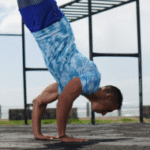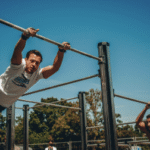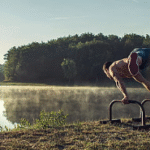Learn Foundational Calisthenics Skills Correctly with a Personal Coach
In the exciting world of calisthenics, the allure of advanced skills like the muscle-up, human flag, or planche is powerful. It’s easy to see these incredible feats of strength on social media and want to jump straight to the finish line. However, calisthenics is a discipline built on a pyramid of skills, and without a perfectly solid base, the entire structure will eventually crumble—often resulting in frustrating plateaus and painful injuries.
This is why learning the foundational skills correctly isn’t just important; it’s everything. Here in Houston, a personal calisthenics coach can be your most valuable asset, ensuring you build your foundation the right way, right from the start.
The “Why” Behind Perfect Form: A Deeper Look at the Basics
Let’s break down three foundational movements and illustrate why “good enough” form is the enemy of long-term progress.
- The Push-up: More Than Just an Arm Exercise
What Beginners Do: Bend their elbows and let their chest drop, often with a sagging lower back and flared elbows.
What a Coach Teaches (The Correct Way): A push-up is a moving plank. A coach will teach you to:
Engage Your Core: Create total-body tension to keep your spine perfectly neutral, preventing lower back strain.
Control Your Scapula: Actively pull your shoulder blades together on the way down (retraction) and push them apart at the top (protraction). This builds shoulder stability and is the bedrock for skills like the handstand push-up and planche.
Protect Your Joints: Position your hands correctly and keep your elbows tucked (not flared out) to protect your wrists and shoulders from injury.
Why it Matters: A sloppy push-up builds weak patterns. A perfect push-up builds the raw strength and stability needed for every advanced pushing movement.
- The Pull-up/Row: The Foundation of All Pulling Strength
What Beginners Do: Yank with their arms and use momentum, with their shoulders shrugged up by their ears.
What a Coach Teaches (The Correct Way): A pull-up is a back exercise first, and an arm exercise second. A coach will ensure you:
Initiate with the Back: Learn to start the pull by depressing and retracting your scapula (pulling your shoulders down and back). This engages your powerful lat muscles instead of just relying on your biceps.
Maintain Full Range of Motion: Go from a full “dead hang” to getting your chin over the bar, building strength through the entire movement.
Use Proper Progressions: If you can’t do a pull-up, a coach won’t just tell you to “keep trying.” They will provide the right progression, like Australian Rows or band-assisted pull-ups, to build the necessary strength safely.
Why it Matters: Incorrect pulling form leads to shoulder impingement and elbow tendonitis. Correct form builds the powerful, healthy back required for the muscle-up and front lever.
- The Bodyweight Squat: The Blueprint for Leg Strength
What Beginners Do: Bend their knees, letting them collapse inward, while keeping their chest upright and not achieving full depth.
What a Coach Teaches (The Correct Way): A squat is a complex movement involving your entire lower body and core. A coach will guide you to:
Achieve Proper Depth: Teach you the mobility and technique to squat so your hips go below your knees, which is essential for full muscle activation.
Maintain Knee and Spine Health: Ensure your knees track over your feet (not caving in) and your spine remains neutral to prevent injury.
Create Torque: Teach you to “screw your feet into the ground” to create tension in your hips, providing stability and power.
Why it Matters: A poor squat reinforces bad movement patterns. A perfect bodyweight squat is the foundation for explosive power, healthy knees, and advanced single-leg skills like the pistol squat.
Why You Can’t Afford to Skip the Coach
You Can’t See Your Own Mistakes: The most significant value of a coach is their trained, external eye. You might feel like your back is straight, but a coach can spot the subtle curve that could lead to injury down the line.
Programming is a Science: A coach doesn’t just correct your form; they provide a logical, personalized plan. They know exactly when to progress you to the next exercise and when to hold back to build more strength. This eliminates guesswork and maximizes efficiency.
Injury Prevention is Priceless: The cost of a few coaching sessions is minuscule compared to the cost (in time, money, and frustration) of rehabilitating an injury caused by improper form. A coach is your best insurance policy against setbacks.
Conclusion: Build Your Foundation to Last
Think of your calisthenics journey like building one of Houston’s iconic skyscrapers. You wouldn’t pour the foundation without an expert engineer ensuring every detail was perfect. Your body deserves the same meticulous attention. Investing in a personal coach to master the fundamentals is the single best decision you can make for your long-term success, health, and enjoyment of this incredible discipline.

Learn Foundational Calisthenics Skills Correctly with a Personal Coach
Route
Calisthenics Gym Houston Functional Bodyweight Training
Secondary phone: (346) 483-3195
Email: info@calisthenicsclubhouston.com
URL: https://calisthenicsclubhouston.com/
Monday 6:00 AM - 7:00 PM Tuesday 6:00 AM - 7:00 PM Open now Wednesday 6:00 AM - 7:00 PM Thursday 6:00 AM - 7:00 PM Friday 12:00 PM - 6:30 PM Saturday 9:45 AM - 12:00 PM Sunday 3:00 PM - 5:00 PM





